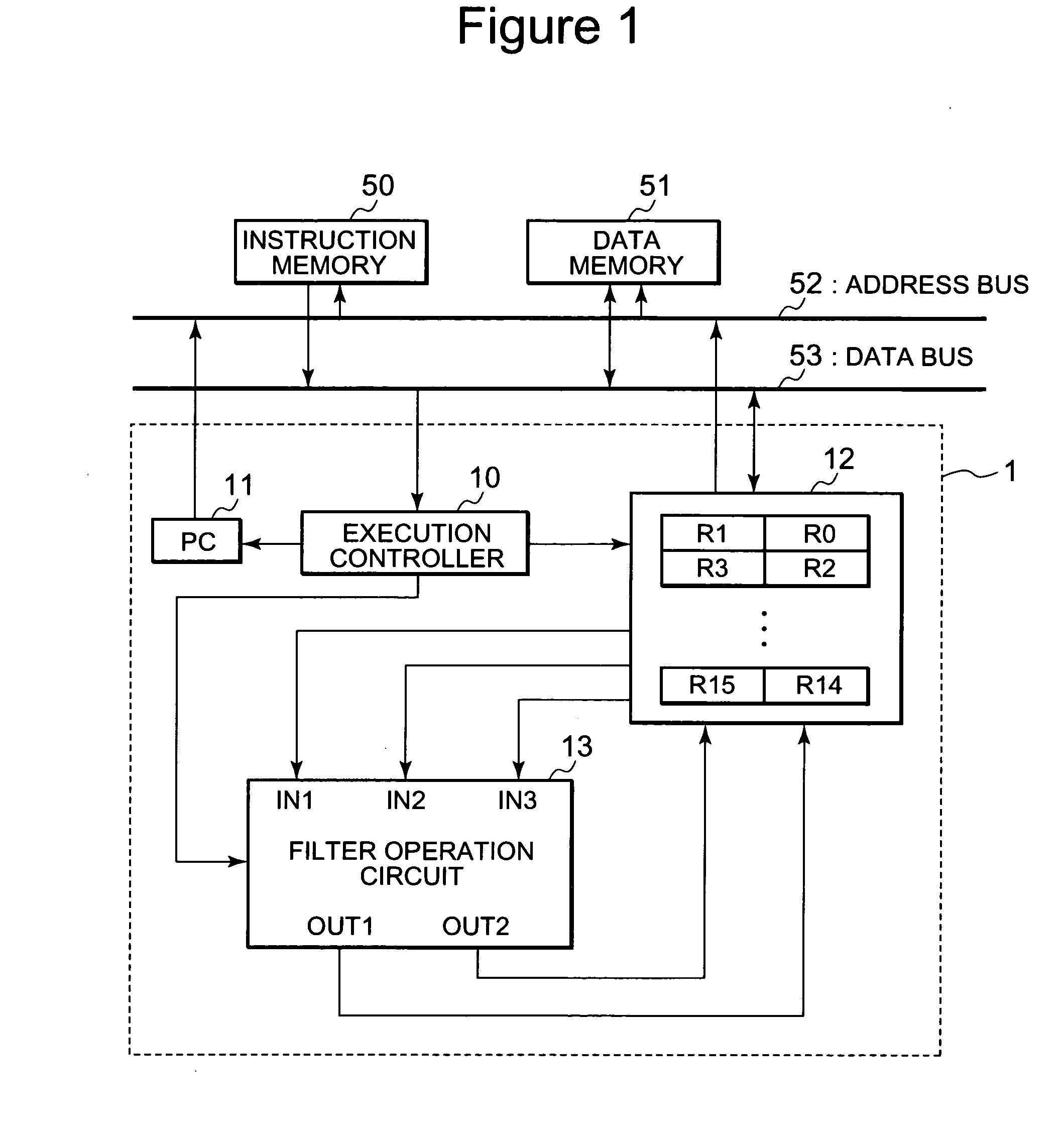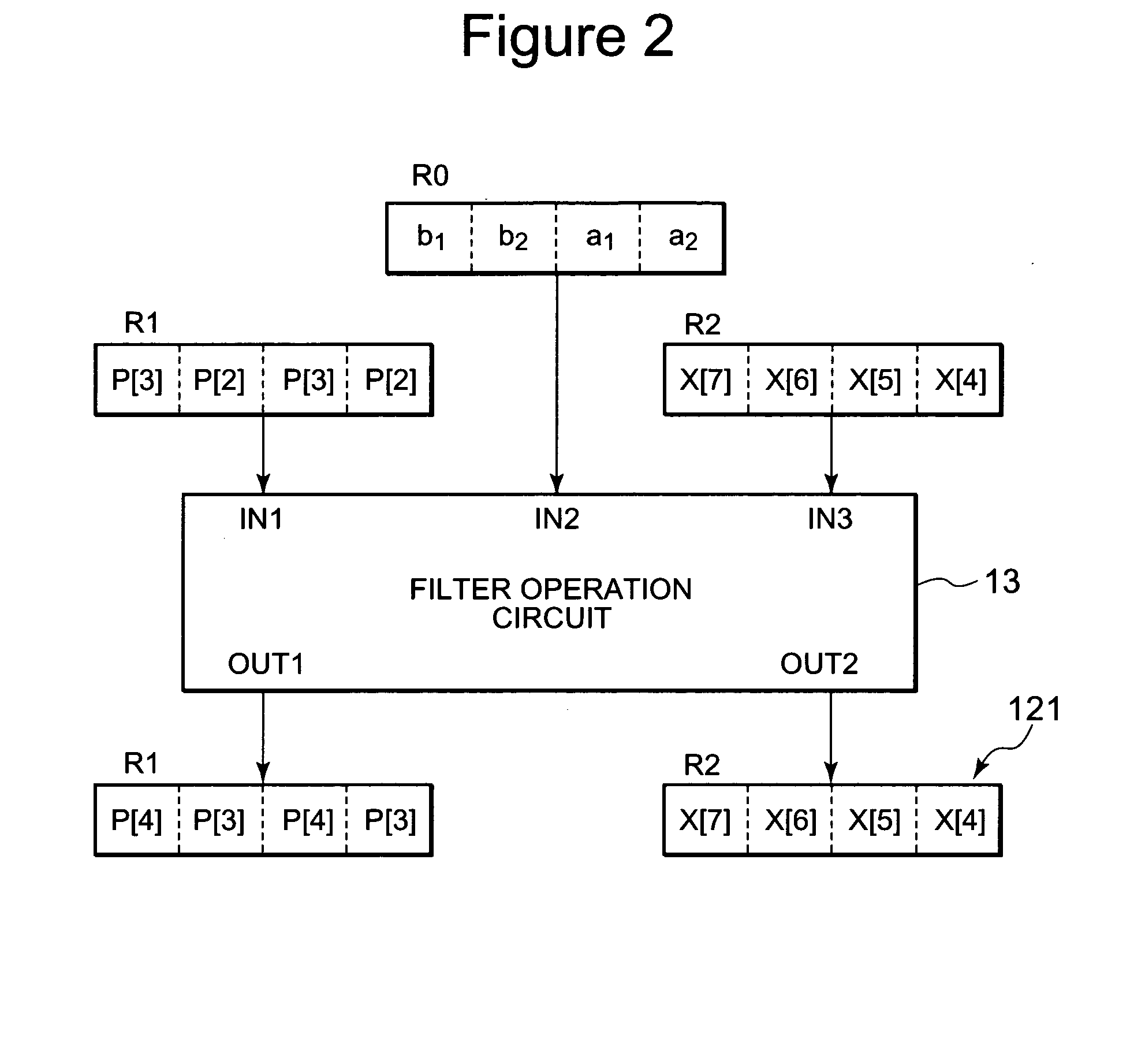Microprocessor performing IIR filter operation with registers
a microprocessor and register technology, applied in the field of microprocessors that perform iir filter operations, can solve the problems of preventing the improvement of the speed of iir filter operations, and achieve the effect of reducing the number or size of accumulators required for executing iir filter operations, reducing the number of executions of redundant data movement instructions and data memory access instructions
- Summary
- Abstract
- Description
- Claims
- Application Information
AI Technical Summary
Benefits of technology
Problems solved by technology
Method used
Image
Examples
first exemplary embodiment
[0046]FIG. 2 shows an example of input and output data in arithmetic processing of the direct-form-II second-order IIR filter 8 shown in FIG. 16 performed by the filter operation circuit 13. Shown in FIG. 2 are input and output data, where the data lengths of all of data X[n] to be subjected to filter operation, data Y[n] subjected to filter operation, intermediate data (transfer data) P[n], and filter coefficients a1, a2, b1, and b2 in the second-order IIR filter 8 are 16 bits, where n=4.
[0047]In FIG. 2, a first general register that provides the filter coefficients a1, a2, b1, and b2 to the filter operation circuit 13 is register R0. Register R0, 64-bit long, according to the embodiment, stores the four filter coefficients, a1, a2, b1, and b2. If the total data amount of filter coefficients to be provided is so large compared with the register length that one general register cannot store all filter coefficients, they may be stored separately in multiple general registers.
[0048]In...
second exemplary embodiment
[0075]An exemplary embodiment will be described in which the arithmetic processing of the direct-form-I second-order IIR filter 7 shown in FIG. 15 is executed by a filter operation circuit 13. In the direct form II described above, intermediate data P[n] expressed by Equation (2) is stored in the second general register as transfer data. In the direct form I in the present exemplary embodiment, X[n−1], X[n], Y[n−1], and Y[n] required for a filter operation on the next sample X [n+1] is preferably stored in the second general register as transfer data, as can be seen from Equation (1).
[0076]In FIG. 6, data X[n] to be subjected to filter operation, data Y[n] subjected to filter operation, transfer data, and filter coefficients a1, a2, b1, and b2 in the second-order IIR filter 7 all have a data length of 16 bits. FIG. 6 shows input and output data, where n=4. The configuration shown in FIG. 6 differs from the direct form II shown in FIG. 2 in transfer data held in register R1.
[0077]FIG...
third exemplary embodiment
[0079]In the present exemplary embodiment, the description will be made of the case in which arithmetic processing of an eighth-order IIR filter 9 in FIG. 17 made up of biquad filters 91 to 94 connected in series is performed by a filter operation circuit 13. In order for the single filter operation circuit 13 to perform operations corresponding to the four biquad filters 91 to 94 connected in series, filter coefficients, transfer data (intermediate data), and data to be subjected to filter operations need to be selectively provided to the filter operation circuit 13. This can be accomplished by changing the first to third general registers specified as the operands of a filter operation instruction (IIRSUM instruction).
[0080]FIG. 8 shows the initial values held in general registers R0 to R8, where the sample number n=4. In FIG. 8, register R0 holds filer coefficients a11, a12, b11, and b12 for biquad filter 91. Similarly, registers R1 to R3 hold the filter coefficients for biquad f...
PUM
 Login to View More
Login to View More Abstract
Description
Claims
Application Information
 Login to View More
Login to View More - R&D
- Intellectual Property
- Life Sciences
- Materials
- Tech Scout
- Unparalleled Data Quality
- Higher Quality Content
- 60% Fewer Hallucinations
Browse by: Latest US Patents, China's latest patents, Technical Efficacy Thesaurus, Application Domain, Technology Topic, Popular Technical Reports.
© 2025 PatSnap. All rights reserved.Legal|Privacy policy|Modern Slavery Act Transparency Statement|Sitemap|About US| Contact US: help@patsnap.com



